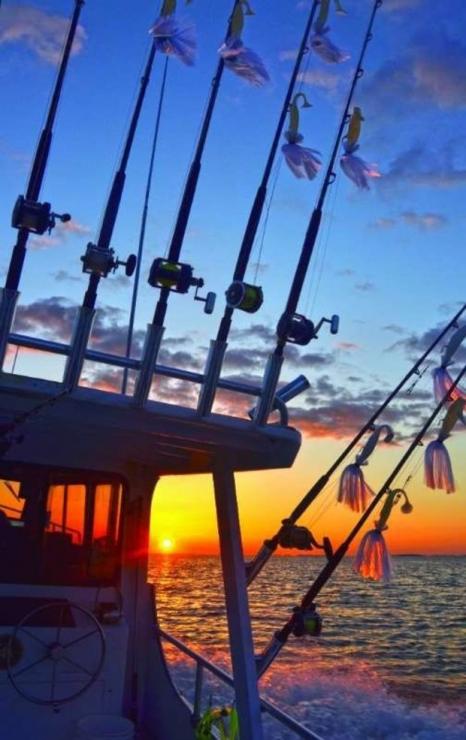If you’re new to trolling for Chesapeake Bay stripers or are considering upgrading your gear, please read on. If you’re happy with your current setup, feel free to read on, or simply pass go and collect your two hundred dollars. But not from me.

When water temperatures drop into the 60s (F) and the days get shorter, an internal switch clicks on in Chesapeake rockfish spurring them to eat more. And then, as fall moves closer to the holidays, these resident stripers are joined by their larger cousins, ocean-run rockfish that spent the summer off New England. In autumn, rockfish can cover a lot of water looking for an abundant food source. Experienced fishermen understand they need to do the same. On the menu are alewives and menhaden, which provide the protein necessary to endure a long winter. Lures that mimic these baits catch best. It’s critical they swim and present a similar profile like a real baitfish. Bucktails, parachutes, umbrella rigs and spoons, often in combination, do that quite well. Practitioners of this skill also know the right rod can mean the difference between consistently hooking up or just hanging out.
A rod not designed to handle the hard strike of a full grown striper or the weight of the lures attached to it does you no good. Yes, I know there are still some guys using decades old fiberglass rods paired with classic reels, such as PENN Senators, and doing so fairly effectively. Modern materials in production rods, however, can arguably be viewed as game changers since trolling a squadron of banjo-eyed parachutes or umbrella rigs is definitely unique to Bay rockfishing. It cannot be done, at least not done well, on a whimsy rod.
Josh Lowery is the sales manager at Island Tackle Outfitters and also an avid angler. I asked him to recommend a good starter Bay trolling rod for the budget conscious fisherman. Hands down, he says, it’s the Ande Standup rods, which come in five-foot, six-inch and six-foot lengths. For fall Bay trolling he recommends an Ande rod in the 20- to 50-pound test class. Made of precision blended, high modulus graphite and fiberglass composite construction, the components, such the aluminum reel seat and rounded gimbal, are of good quality, says Josh. The bonus is the price: under $60. “I’ve caught 60-pound yellowfin tuna with these rods,” he adds.
Another quality rod worth considering, and which definitely won’t bust the budget, is also built specifically for the Chesapeake striper fishery. The four rods in the Cove Chesapeake Series by Tackle Cove are all under $100. A good basic setup is five-foot, six-inch or six-foot medium trolling rods, says Charter Captain Mark Galasso who likes to mix rod sizes. “Longer rods give you more clearance so (fishing) line passes over the tips of shorter rods when you make a sharp turn,” he says. “I also like roller tips since I rig my reels with #80 PowerPro, generally 200 yards (of the braid) and the rest 30-pound mono backing.” Mark and other skippers like the heavier Cove rods for running weighted parachutes deeper off the stern, with the six-foot, six-inch rods better off the sides for clearance.
At some point in the fishing lives of almost every serious angler they contemplate having a custom rod built. Some cannot resist this urge and take the plunge. Custom rods are pricey, ranging from a few hundred dollars to well past a grand. That’s a lot of cheddar just to try and catch a fish, but there’s good reason for the cost. I asked professional rod builder Joe Cap of Shore Tackle and Custom Rod, the company founded by expert rod builder Bill O’Brien, what should fishermen look for when considering a custom Bay trolling rod.
“There are three important elements,” he explains. “1. Ensuring the (finished) rod is crafted according to the specific characteristics of the rod blank; 2. Use only the highest quality components, like titanium guides that flex with the rod; 3. Make sure the rod has a high-quality butt—for example, the aluminum unibutt is locked into the blank so it (reel seat) doesn’t spin on the rod. That’s usually not available from a factory rod.”
As you’d expect, there are lots of trolling rod out there, some good, some great, and few that are plain junk. And for those of us just starting out, we have lots of questions, such as e-glass and graphite? What’s the best butt: EVA, unibutts, and slick butts? Are roller guides better than turbo guides? What about guide frames? Silicon carbide, zirconium, harloy, or rollers?
So the best advice I can pass along is to stop into your local shop and spend time talking with a rod expert. When that trophy fish comes alongside the gunwale, you’ll be glad you did.
by Captain Chris D. Dollar